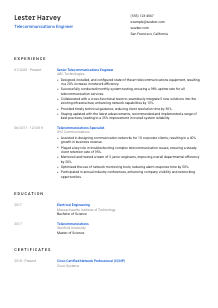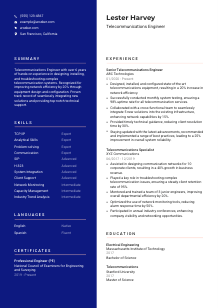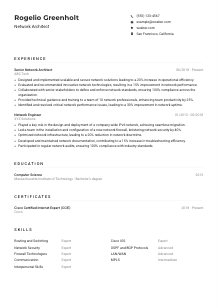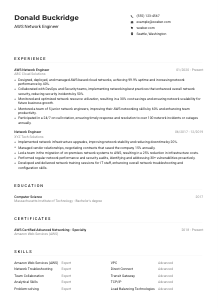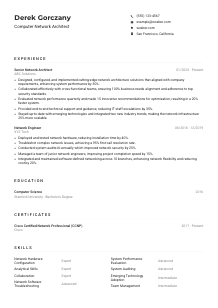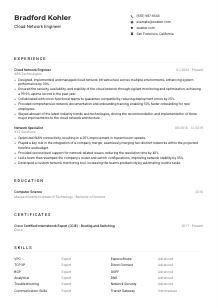Telecommunications Engineer Resume Example
Connecting signals, but your resume has no bars? Dive into this Telecommunications Engineer resume example, set up with Wozber free resume builder. Understand how to bridge your network expertise with job requirements, so your career connection is always at full 4G speed!
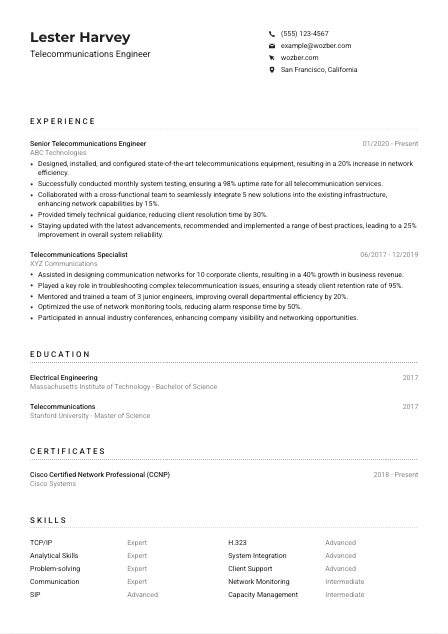
How to write a Telecommunications Engineer resume?
Hello there, soon-to-be Telecommunications Engineer marvel! In the bustling field of telecommunications, where technology evolves at the speed of light, crafting a resume that stands tall like a tower in a cityscape is not a mere wish—it's a must. With Wozber by your side, equipped with a free resume builder and a suite of tools like ATS-friendly resume templates and an ATS resume scanner, you're about to embark on a journey. A journey that will transform your resume into a compelling narrative, finely tuned to the unique frequencies of your desired job.
Ready to dial in? Let's get to it!
Personal Details
The Personal Details section is where your resume begins to transmit. It's vital to get this right, as it's your first point of contact with potential employers. We'll craft it with precision, keeping the role of a Telecommunications Engineer in mind.
1. Tune in With Your Name
Your name is the beacon atop your resume. Make it prominent, clear, and easy to find. Think of it as the signal you're sending out—strong and unmistakable.
2. Ensure the Title Resonates
Including the job title from the job description lets the hiring manager know you're in tune. For this ride, it's ‘Telecommunications Engineer.' Place it right under your name, making an immediate connection to the role you're eyeing.
3. Connect With Essential Contact Details
List your most reliable phone number and a professional email. Consider this: 'example@wozber.com.' Ensure there's no interference—double-check those details for accuracy.
4. Localize Your Coordinates
State your location, emphasizing you're either in the job's locale or willing to relocate. Mention ‘San Francisco, California' clearly, indicating you're ready to be on-site or make the move.
5. Add a Professional Channel
If you have a LinkedIn profile or professional website, include it. Just like a broadcaster needs a station, you need a platform where employers can tune in to more about you.
Takeaway
Personal Details is your resume's handshake—strong, confident, and engaging. With your details dialed in, you've set the stage for an unforgettable first impression!





Experience
Your experience section is the main broadcast of your resume. It's where you showcase the depth of your engineering prowess. Crafting this with the job's frequency in mind will ensure your signal comes through loud and clear.
- Designed, installed, and configured state‑of‑the‑art telecommunications equipment, resulting in a 20% increase in network efficiency.
- Successfully conducted monthly system testing, ensuring a 98% uptime rate for all telecommunication services.
- Collaborated with a cross‑functional team to seamlessly integrate 5 new solutions into the existing infrastructure, enhancing network capabilities by 15%.
- Provided timely technical guidance, reducing client resolution time by 30%.
- Staying updated with the latest advancements, recommended and implemented a range of best practices, leading to a 25% improvement in overall system reliability.
- Assisted in designing communication networks for 10 corporate clients, resulting in a 40% growth in business revenue.
- Played a key role in troubleshooting complex telecommunication issues, ensuring a steady client retention rate of 95%.
- Mentored and trained a team of 3 junior engineers, improving overall departmental efficiency by 20%.
- Optimized the use of network monitoring tools, reducing alarm response time by 50%.
- Participated in annual industry conferences, enhancing company visibility and networking opportunities.
1. Decode the Job Signal
Start with a deep dive into the job description, highlighting every requirement that matches your own experience. This is like tuning into the right frequency before you start transmitting.
2. Align Your Roles and Employers
List your past roles in reverse-chronological order. Be clear about your titles, the companies you've worked with, and the time frames. This clarity ensures your career narrative will be easy to follow.
3. Craft Targeted Broadcasts
For each role, list accomplishments that mirror the job's requirements. Statements like ‘Designed, installed, and configured state-of-the-art telecommunications equipment' directly address listed responsibilities, showing you're on the right frequency.
4. Amplify with Numbers
Whenever possible, quantify your achievements. Saying ‘resulting in a 20% increase in network efficiency' turns abstract accomplishments into measurable successes.
5. Filter Out Static
Keep your content laser-focused on what matters for a Telecommunications Engineer role. Remove anything that doesn't contribute to that signal. This keeps your message clear and potent.
Takeaway
At its core, your experience section is your professional broadcast. Tailoring it means ensuring your signal is strong, clear, and perfectly pitched to the role you're applying for. It's not just about where you've been—it's about showcasing how ready you are for this next step.
Education
In the telecommunications realm, your educational background lays the foundational cables for your expertise. Let's ensure this section of your resume is as robust and reliable as a fiber optic network.
1. Identify the Connection Points
Isolate the educational requirements from the job listing. For our Telecommunications Engineer role, a ‘Bachelor's degree in Telecommunications, Electrical Engineering, or a related field' is essential.
2. Structure Your Network
Maintain a simple yet effective structure in this section. List your degree, the field of study, and the institution, followed by your graduation year. This keeps your educational network easy to navigate.
3. Match the Frequency
If the job specifically mentions a degree or field of study, make sure yours aligns perfectly. Citing ‘Bachelor of Science in Electrical Engineering and Master of Science in Telecommunications' directly responds to the role's requirements.
4. Include Relevant Nodes
If early in your career or in highly specialized roles, listing relevant courses can enhance your profile. Though not needed in our example, it's a potent connector for someone dialing into their first Telecommunications Engineer role.
5. Highlight Additional Signals
Don't overlook related clubs, honors, or projects that align with your career goals. These extras can show depth and engagement beyond the classroom, though their relevance fades as you gain more field experience.
Takeaway
Your education section shines a light on the foundation of your expertise. By structuring this part of your resume with clarity and relevance, you solidify your status as a well-rounded candidate, ready to navigate the complex networks of the telecommunications field.
Certificates
In the fast-evolving field of telecommunications, certifications act as amplifiers to your professional signal. They're proof of your commitment and expertise. Let's pinpoint how to make them resonate.
1. Scan for Relevant Frequencies
Start by identifying any certifications directly mentioned or implied in the job posting. Though our Telecommunications Engineer example didn't specify, certifications like CCNP or PE can be highly relevant.
2. Select Your Strongest Signals
Rather than listing every certification you've earned, choose those that are most relevant to the role. It's about quality over quantity, ensuring your strongest and most relevant certifications are immediately visible.
3. Clarify the Bandwidth
For certifications, especially in tech, clarity on validity periods or recency can be crucial. Listing dates for certifications like ‘Cisco Certified Network Professional (CCNP) - 2018 - Present' shows your credentials are current.
4. Stay on the Leading Edge
The tech field moves fast, and so should you. Continually updating your certifications and seeking out new learning opportunities, especially those aligning with your career path, keeps your signal strong in a competitive field.
Takeaway
Your certifications are powerful endorsements of your skills and dedication. Highlighting them in your resume not only illustrates your technical prowess but also your ongoing commitment to professional growth. Make them count!
Skills
Your skills section is where you get to show off the tools in your professional toolkit. It's crucial that these align with the Telecommunications Engineer role you're applying for. Let's fine-tune this section to ensure it resonates.
1. Decode the Brief
First, identify both the stated and the implied skills in the job description. Skills like ‘In-depth knowledge of TCP/IP' are explicit, while ‘strong analytical skills' might be implied in responsibilities like troubleshooting.
2. Highlight Your Core Frequencies
Match the job's required skills with your own, and list them clearly. ‘TCP/IP' and ‘strong analytical skills' are essentials in this case. Prioritize these, ensuring they are the first ones the hiring manager sees.
3. Organize for Optimal Signal
While you might be tempted to list every skill you have, focus on those most relevant to your role as a Telecommunications Engineer. This approach keeps your resume clean, clear, and targeted.
Takeaway
The skills section is your professional highlight reel. Make sure every skill listed is a direct hit on the job's requirements. This precision shows you're not just a match for the role—you're the perfect fit.
Languages
In a connected world, speaking multiple languages can set you apart. Let's ensure the Languages section of your resume does justice to your linguistic capabilities, especially important for roles that have a global footprint.
1. Tune Into the Requirements
First off, check if the job listing specifies language requirements. For a Telecommunications Engineer, fluency in English was highlighted. That's your starting point.
2. Broadcast Your Main Frequency
List your proficiency in the required language, in this case, English, at the top. Indicate your level clearly, be it native or fluent.
3. Add Additional Channels
Even if not specified, other languages you speak can be a bonus. In areas like customer support or international projects, additional languages can be a significant advantage.
4. Be Transparent About Your Range
When listing languages, be honest about your level of proficiency using clear terms like ‘fluent' or ‘intermediate.' This ensures expectations are set correctly.
5. Gauge the Global Scope
For roles that involve interaction across borders or with multinational teams, your ability to communicate in multiple languages showcases your potential as a global communicator.
Takeaway
Your linguistic skills embody your ability to connect and communicate in a global marketplace. Highlighting these not only showcases a valuable skill set but also predisposes you as a candidate with a broader perspective. Speak the world's language, and let your resume echo your global aptitude.
Summary
The summary is your professional teaser, a potent snippet that encapsulates your career highlights. Let's distill your journey into a compelling summary that resonates with the keynotes of the Telecommunications Engineer role.
1. Dial Into the Role
Begin by fully absorbing the essence of the job description. This aids in crafting a summary that's aligned with the expectations.
2. Initiate the Signal
Open your summary with an introduction to your professional self. Consider starting with ‘Telecommunications Engineer with over 6 years of hands-on experience…' to immediately establish relevance.
3. Highlight the Connection Points
Enumerate skills and achievements that link directly to the job's needs. Referencing improvements in network efficiency and project leadership immediately flags your value.
4. Keep It Crystal Clear
Your summary should be concise yet impactful. Within 3-5 lines, you need to broadcast your fit for the role, encapsulating why you're the engineer they're searching for.
Takeaway
The summary is your elevator pitch to the hiring manager. By crafting it with precision, focusing on what makes you uniquely suited for the Telecommunications Engineer role, you set the stage for everything that follows. Let it be the calling card that invites them to explore the intricate network of skills and experiences detailed in the rest of your resume.
Launching Your Telecommunications Engineer Journey
Congratulations on completing your guide to shaping a standout Telecommunications Engineer resume! With your resume now finely tuned and broadcast-ready, you're poised to make waves in your job search. Remember, your resume is more than just a document—it's a reflection of your professional journey, a beacon that guides potential employers to your capabilities. Use the tools Wozber offers, from a free resume builder to ATS-friendly resume templates and the ATS resume scanner, to ensure your resume doesn't just land on desks—it lands you interviews.
The airwaves are waiting for your signal. It's time to transmit your career to new heights!

- Bachelor's degree in Telecommunications, Electrical Engineering, or a related field.
- Minimum of 5 years of experience in designing, implementing, and troubleshooting complex telecommunication systems.
- In-depth knowledge of various telecommunications protocols, including TCP/IP, SIP, and H.323.
- Familiarity with network monitoring tools and capacity management practices.
- Strong analytical, problem-solving, and communication skills, both written and verbal.
- English fluency is a critical requirement.
- Must be located in or willing to relocate to San Francisco, CA.
- Design, install, and configure telecommunications equipment, networks, and systems.
- Conduct regular system testing and performance evaluations to ensure reliable and efficient operation.
- Collaborate with cross-functional teams to integrate new solutions and upgrades into the existing infrastructure.
- Provide technical support and guidance to both internal teams and external clients.
- Stay updated with industry trends and advancements to recommend and implement best practices.





